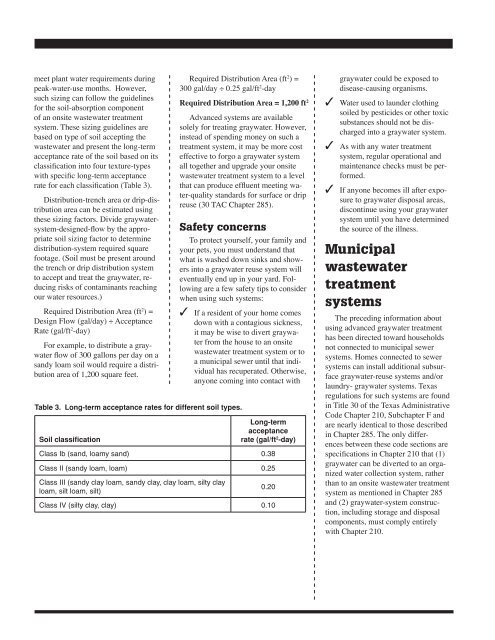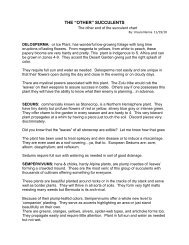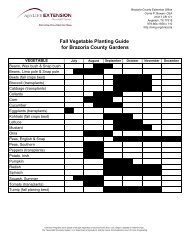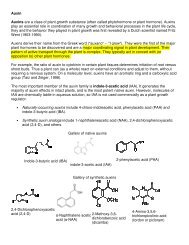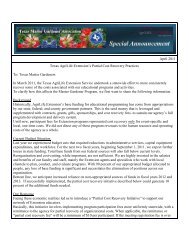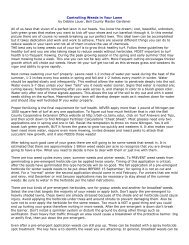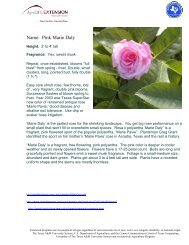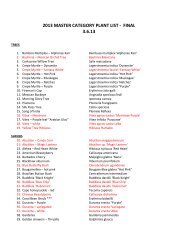Graywater - Texas Master Gardeners Association
Graywater - Texas Master Gardeners Association
Graywater - Texas Master Gardeners Association
You also want an ePaper? Increase the reach of your titles
YUMPU automatically turns print PDFs into web optimized ePapers that Google loves.
meet plant water requirements during<br />
peak-water-use months. However,<br />
such sizing can follow the guidelines<br />
for the soil-absorption component<br />
of an onsite wastewater treatment<br />
system. These sizing guidelines are<br />
based on type of soil accepting the<br />
wastewater and present the long-term<br />
acceptance rate of the soil based on its<br />
classification into four texture-types<br />
with specific long-term acceptance<br />
rate for each classification (Table 3).<br />
Distribution-trench area or drip-distribution<br />
area can be estimated using<br />
these sizing factors. Divide graywatersystem-designed-flow<br />
by the appropriate<br />
soil sizing factor to determine<br />
distribution-system required square<br />
footage. (Soil must be present around<br />
the trench or drip distribution system<br />
to accept and treat the graywater, reducing<br />
risks of contaminants reaching<br />
our water resources.)<br />
Required Distribution Area (ft 2 ) =<br />
Design Flow (gal/day) ÷ Acceptance<br />
Rate (gal/ft 2 -day)<br />
For example, to distribute a graywater<br />
flow of 300 gallons per day on a<br />
sandy loam soil would require a distribution<br />
area of 1,200 square feet.<br />
Required Distribution Area (ft 2 ) =<br />
300 gal/day ÷ 0.25 gal/ft 2 -day<br />
Table 3. Long-term acceptance rates for different soil types.<br />
Soil classification<br />
Required Distribution Area = 1,200 ft 2<br />
Advanced systems are available<br />
solely for treating graywater. However,<br />
instead of spending money on such a<br />
treatment system, it may be more cost<br />
effective to forgo a graywater system<br />
all together and upgrade your onsite<br />
wastewater treatment system to a level<br />
that can produce effluent meeting water-quality<br />
standards for surface or drip<br />
reuse (30 TAC Chapter 285).<br />
Safety concerns<br />
To protect yourself, your family and<br />
your pets, you must understand that<br />
what is washed down sinks and showers<br />
into a graywater reuse system will<br />
eventually end up in your yard. Following<br />
are a few safety tips to consider<br />
when using such systems:<br />
If a resident of your home comes<br />
down with a contagious sickness,<br />
it may be wise to divert graywater<br />
from the house to an onsite<br />
wastewater treatment system or to<br />
a municipal sewer until that individual<br />
has recuperated. Otherwise,<br />
anyone coming into contact with<br />
Long-term<br />
acceptance<br />
rate (gal/ft 2 -day)<br />
Class Ib (sand, loamy sand) 0.38<br />
Class II (sandy loam, loam) 0.25<br />
Class III (sandy clay loam, sandy clay, clay loam, silty clay<br />
loam, silt loam, silt)<br />
0.20<br />
Class IV (silty clay, clay) 0.10<br />
graywater could be exposed to<br />
disease-causing organisms.<br />
Water used to launder clothing<br />
soiled by pesticides or other toxic<br />
substances should not be discharged<br />
into a graywater system.<br />
As with any water treatment<br />
system, regular operational and<br />
maintenance checks must be performed.<br />
If anyone becomes ill after exposure<br />
to graywater disposal areas,<br />
discontinue using your graywater<br />
system until you have determined<br />
the source of the illness.<br />
Municipal<br />
wastewater<br />
treatment<br />
systems<br />
The preceding information about<br />
using advanced graywater treatment<br />
has been directed toward households<br />
not connected to municipal sewer<br />
systems. Homes connected to sewer<br />
systems can install additional subsurface<br />
graywater-reuse systems and/or<br />
laundry- graywater systems. <strong>Texas</strong><br />
regulations for such systems are found<br />
in Title 30 of the <strong>Texas</strong> Administrative<br />
Code Chapter 210, Subchapter F and<br />
are nearly identical to those described<br />
in Chapter 285. The only differences<br />
between these code sections are<br />
specifications in Chapter 210 that (1)<br />
graywater can be diverted to an organized<br />
water collection system, rather<br />
than to an onsite wastewater treatment<br />
system as mentioned in Chapter 285<br />
and (2) graywater-system construction,<br />
including storage and disposal<br />
components, must comply entirely<br />
with Chapter 210.


